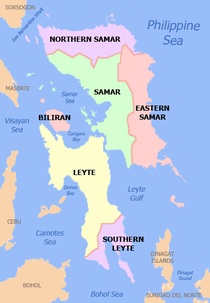Ormoc
| Ormoc | ||
|---|---|---|
| Independent Component City | ||
| City of Ormoc | ||
|
View of Ormoc from Ormoc Bay | ||
| ||
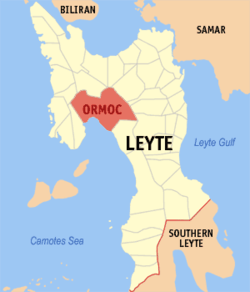 Map of Leyte showing the location of Ormoc City | ||
.svg.png) Ormoc Location within the Philippines | ||
| Coordinates: 11°01′N 124°37′E / 11.02°N 124.62°ECoordinates: 11°01′N 124°37′E / 11.02°N 124.62°E | ||
| Country |
| |
| Region | Eastern Visayas (Region VIII) | |
| Province | Leyte (geographically only) | |
| District | 4th district of Leyte | |
| Founded | 26 February 1834 | |
| Cityhood | 21 June 1947 | |
| Barangays | 110 | |
| Government[1] | ||
| • Mayor | Richard Gomez | |
| • Vice-Mayor | Leo Carmelo "Toto Jr." Locsin | |
| • Representative (Congressman) | Lucy Torres-Gomez | |
| Area[2] | ||
| • Total | 613.6 km2 (236.9 sq mi) | |
| Population (2015 census)[3] | ||
| • Total | 215,031 | |
| • Density | 350/km2 (910/sq mi) | |
| Demonym(s) | Ormocanon | |
| Time zone | PHT (UTC+8) | |
| ZIP code | 6541 | |
| Dialing code | +63 (0)53 | |
| Income class | 1st class city | |
| Languages | Cebuano and other minority languages | |
| Website |
www | |
Ormoc, officially the City of Ormoc (Cebuano: Dakbayan sa Ormoc; Filipino: Lungsod ng Ormoc) or simply referred to as Ormoc City, is an independent component city in the province of Leyte in the region of Eastern Visayas of the Philippines. According to the 2015 census, it has a population of 215,031 inhabitants,[3] making it the second most-populous city in the province after the provincial capital, Tacloban City. Ormoc is the economic, cultural, commercial and transportation hub of western Leyte.
Ormoc City is an independent component city, not subject to regulation from the Provincial Government of Leyte. However, the city is part of the IV Congressional District of Leyte together with Albuera, Kananga, Merida, Palompon and Isabel. On November 8, 2013, the city was extensively damaged by Super Typhoon Yolanda (Haiyan), having previously suffered severe destruction and loss of life in 1991 from torrential flooding during Tropical Storm Thelma (Uring).
The city's name is derived from ogmok, an archaic Visayan term for "lowland" or "depressed plain".
Geography
Ormoc City is a port city and is the largest city in Leyte by land area and the second largest in Eastern Visayas after Calbayog City in Samar. At the head of Ormoc Bay, the city's terrain is mostly of gently rolling plains. It is bounded on the northwest by the towns of Matag-ob and Merida, in the north by Kananga, in the northeast by the towns of Jaro, Pastrana and Dagami, and in the south by the town of Albuera. High mountain ranges separate Ormoc from the eastern portion of Leyte. Numerous rivers and streams traverse Ormoc. Among them are the Bao River in the north, Pagsangahan River in the west, the Bagong-bong River in the south, the Panilahan River also in the south and the Anilao and Malbasag Rivers which border the eastern and western flanks of Ormoc City Proper.
Barangays
Ormoc City is politically subdivided into 110 barangays.[2]
- Airport
- Alegria
- Alta Vista
- Bagong
- Bagong Buhay
- Bantigue
- Barangay 1 (Pob.)
- Barangay 2 (Pob.)
- Barangay 3 (Pob.)
- Barangay 4 (Pob.)
- Barangay 5 (Pob.)
- Barangay 6 (Pob.)
- Barangay 7 (Pob.)
- Barangay 8 (Pob.)
- Barangay 9 (Pob.)
- Barangay 10 (Pob.)
- Barangay 11 (Pob.)
- Barangay 12 (Pob.)
- Barangay 13 (Pob.)
- Barangay 14 (Pob.)
- Barangay 15 (Pob.)
- Barangay 16 (Pob.)
- Barangay 17 (Pob.)
- Barangay 18 (Pob.)
- Barangay 19 (Pob.)
- Barangay 20 (Pob.)
- Barangay 21 (Pob.)
- Barangay 22 (Pob.)
- Barangay 23 (Pob.)
- Barangay 24 (Pob.)
- Barangay 25 (Pob.)
- Barangay 26 (Pob.)
- Barangay 27 (Pob.)
- Barangay 28 (Pob.)
- Barangay 29 (Pob.)
- Batuan
- Bayog
- Biliboy
- Borok
- Cabaon-an
- Cabintan
- Cabulihan
- Cagbuhangin
- Camp Downes
- Can-adieng
- Can-untog
- Catmon
- Cogon Combado
- Concepcion
- Curva
- Danao
- Danhug
- Dayhagan
- Dolores
- Domonar
- Don Felipe Larrazabal
- Don Potenciano Larrazabal
- Doña Feliza Z. Mejia
- Donghol
- Esperansa
- Gaas
- Green Valley
- Guintigui-an
- Hibunawon
- Hugpa
- Ipil
- Juaton
- Kadaohan
- Labrador (Balion)
- Lao
- Leondoni
- Libertad
- Liberty
- Licuma
- Liloan
- Linao
- Luna
- Mabato
- Mabini
- Macabug
- Magaswi
- Mahayag
- Mahayahay
- Manlilinao
- Margen
- Mas-in
- Matica-a
- Milagro
- Monterico
- Nasunogan
- Naungan
- Nueva Sociedad
- Nueva Vista
- Patag
- Punta
- Quezon, Jr.
- Rufina M. Tan
- Sabang Bao
- Salvacion
- San Antonio
- San Isidro
- San Jose
- San Juan
- San Pablo (Simangan)
- San Vicente
- Santo Niño
- Sumangga
- Tambulilid
- Tongonan
- Valencia
History
Kananga was created in 1950 from the barrios of Lonoy, Kananga, Rizal, Tugbong, Montebello, Aguiting, Tagaytay, Montealegre, Libungao, Naghalin, and Masarayao which all used to be part of Ormoc City.[4]
1991 Flash Flood
On the morning of 5 November 1991, the Ormoc region was inundated by Tropical Storm Uring. The city government recorded 4,922 deaths, 3,000 missing persons, 14,000 destroyed houses and more than P600 million worth of damaged property.[5] None of the 3,000 missing persons were ever found and are now presumed dead.[6] Illegal logging and kaingin (slash-and-burn farming) were blamed as the reasons of the flood.[5] Heavy rainfall caused water to collect upstream the Anilao and Malbasag rivers until it poured to the lowlands in Ormoc, particularly District 26, also known as Isla Verde.[5]
On 5 November 2011, a monument by national artist Francis Cinco commemorating the 20th anniversary of the event was inaugurated.[7] It sits on top of the mass grave at the Ormoc City Public Cemetery where an estimated 4,900 victims are buried.[8] The sculpture, entitled "Gift of Life", is an abstract depicting a life taken to heaven.[5][7]
2006 Store Fire
A fire at the Unitop store killed 24 people on Christmas day. The fire started from firecrackers and pyrotechnics that were ignited near the entrance door. The store did not have a permit to sell firecrackers and emergency exits were locked. The charred remains of the victims were found inside a bathroom, where they tried to escape from the blaze.
Demographics

| Population census of Ormoc | ||
|---|---|---|
| Year | Pop. | ±% p.a. |
| 1990 | 129,456 | — |
| 1995 | 143,186 | +1.91% |
| 2000 | 154,297 | +1.62% |
| 2007 | 177,524 | +1.95% |
| 2010 | 191,200 | +2.74% |
| 2015 | 215,031 | +2.26% |
| Source: National Statistics Office[3][9] | ||
The natives of this city are called Ormocanons, with most being Cebuano speakers (or Kana, as Cebuano-speakers in Leyte and Southern Leyte are often called by the Waray people) together with the whole western and southern parts of the island of Leyte.
Like most Filipinos, Ormocanons are predominantly Roman Catholic, and the city celebrates its annual fiesta in honour of the patron saints Saint Peter and Saint Paul on June 28 and 29. Other main Catholic holy days, including the local fiestas of barangays, are observed throughout the year. There is also a visible Muslim minority within the city and all over the island, evidenced by the mosques within the cityscape and most of them are Maranaos from the twin provinces of Lanao del Norte and Lanao del Sur in Mindanao.
Economy
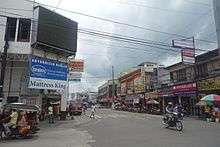

Ormoc City's economic base is a good mix of agriculture, aquaculture, industry, tourism, and commercial services. Sugar cane, rice and pineapple are the bulk produce of the agricultural sector.
The city enjoys economic growth because it supplies a large part of the country's power needs with its abundant geothermal power resources from the Tongonan Geothermal Power Plant in Barangay Tongonan and neighbouring Kananga town. Ormoc is also the gateway to the Leyte Industrial Development Estate in the nearby town of Isabel, home of the Philippine Phosphate Fertilizer Plant, the largest fertilizer factory in Asia, and the Philippine Associated Smelter and Refining Company, the country's biggest copper processing plant, among other industries.
Education
Ormoc is the educational center for western Leyte. It has a range of primary and secondary schools, both public and private. Tertiary education was originally offered by St. Peter's College of Ormoc, a Benedictine-run Catholic college and the oldest, followed by Western Leyte College of Ormoc City, Inc.,[10] a private non-sectarian college. In the 1990s, the city saw the establishment of Sto. Niño College of Ormoc, St. Paul's School of Ormoc Foundation, Inc. and the STI Computer College - Ormoc. In the 2000s, tertiary institutions founded were AMA Computer Learning Center (ACLC) - Ormoc, San Lorenzo Ruiz College of Ormoc, Ormoc City Institute of Technology (OCIT) and the Ormoc campus of the Eastern Visayas State University.
Ormoc also has their own Chinese school which is Ormoc Se San School.
Attractions
Tourism highlights include:
- Lake Danao is a violin shaped lake 3 km long at an elevation of 2,100 feet (640 m) above sea level. There are floating cottages, and boats are available for hire and a future zipline.
- Tongonan Hotsprings National Park is a valley of geothermal power source that can supply electricity to the whole region. The first geothermal plant to operate in the Philippines.
- Leyte Golf and Country Club is a golfing resort covering more than 80 hectares of semi-rolling terrain, located 7 km from the heart of Ormoc City.
- Pineapple Plantation lies in 210 hectares in rolling terrain located north of the city Brgy. Hibunawon. Ormoc's Queen Pineapple is famous for its sweetness, a favourite pasalubong, and the unofficial icon of the city.
- Centennial Park, located in the city, is a leisure and picnic ground for the young and old alike.
- Cave located at RM Tan.
Infrastructure
Transport
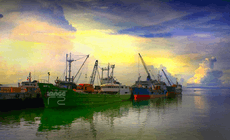

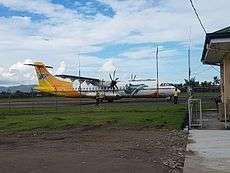
FastCrafts:
- 2GO : Ormoc to Cebu and vice versa
- Weesam Express : Ormoc to Cebu and vice versa
- OceanJet : Ormoc to Cebu and vice versa
Ferry boats:
- Roble Shipping Inc. : Ormoc to Cebu and vice versa
- Lite Shipping : Ormoc to Cebu and vice versa
- Jomalia Shipping : Ormoc to Pilar, Camotes and vice versa
Airlines:
- Cebu Pacific :Ormoc to Cebu and vice versa
Energy
Ormoc City boasts the biggest geothermal powerplant in Southeast Asia - the Tongonan Geothermal Power in Barangay Tongonan which supplies electricity not only in the Eastern Visayas Region but power demand in Luzon as well.
Water
Ormoc gets its water for the dwellers at a lake called Danaw Lake (Coordinates N11.0698/E124.6976). Gravity fed water distribution are experienced here.
References
- ↑ "Cities". Quezon City, Philippines: Department of the Interior and Local Government. Retrieved 19 June 2013.
- 1 2 "Province: Leyte". PSGC Interactive. Makati City, Philippines: National Statistical Coordination Board. Retrieved 19 June 2013.
- 1 2 3 "Region VIII (EASTERN VISAYAS)". Census of Population (2015): Total Population by Province, City, Municipality and Barangay (Report). PSA. Retrieved 20 June 2016.
- ↑ "An act creating the municipality of Kananga, Leyte, in the province of Leyte". LawPH.com. Retrieved 9 April 2011.
- 1 2 3 4 "Ormoc rises from flash flood tragedy". Inquirer.net. Retrieved 20 May 2013.
- ↑ "Tortured by Typhoons". Retrieved 20 May 2013.
- 1 2 "Monument marks 20th year of Ormoc flashflood tragedy". Inquirer.net. Retrieved 20 May 2013.
- ↑ "Mass Grave". Fran-Con Viaje International. Retrieved 20 May 2013.
- ↑ "Total Population by Province, City, Municipality and Barangay: as of 1 May 2010" (PDF). 2010 Census of Population and Housing. National Statistics Office. Retrieved 19 June 2013.
- ↑ WLC-Website
External links
| Wikimedia Commons has media related to Ormoc. |
| Wikivoyage has a travel guide for Ormoc. |
- Official City Government Website of Ormoc
- Ormoc City Local Newspaper
- Ormoc City Online Newspaper
- Official Ormoc City Tourism Website
- Philippine Standard Geographic Code for Ormoc City
- Philippine Census of Population
- Local Governance Performance Management System
- Ormoc on Facebook
 |
Matag-ob | Kananga / Carigara | Jaro |  |
| Merida | |
Pastrana Dagami | ||
| ||||
| | ||||
| Ormoc Bay | Albuera / Burauen |


